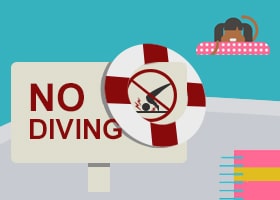If you’re often coming home from work with a stiff neck, shoulder pain, and chronic headaches, you may be suffering from a repetitive stress injury related to your job. If you’re holding the same position with your upper body for long periods of time throughout the day, you’re more likely to sustain a repetitive strain injury. In this video, a massage therapist from the Carrington College massage therapy program explains how to get rid of neck pain with some simple stretching and massage techniques. http://youtu.be/KP2RFdZg4Ds
Stretches for Neck Pain Relief
While workers in a variety of fields—from industrial, to tech, to health care—can find themselves stuck in static positions, there are some posture distortions that are common among office workers. When sitting at a desk and working at a computer, office workers tend to hunch over and bring their arms forward. Below are some easy stretching exercises you can do at your desk to help alleviate neck pain and headaches resulting from work-related physical stress. Side Neck Stretch: Sit up straight, pushing your shoulders back. Tilt the head toward your right shoulder. Place your right hand on the top of the head and gently pull down, bringing the right ear closer to the right shoulder and stretching out the muscles on the left side of the neck. Repeat on the other side. Forward Neck Stretch: Place both hands on the back of the head, pulling the head forward until your chin is nearly touching your collarbone and you are looking at your chest. You should feel tension in the muscles in the back of the neck easing. Alternate Neck Stretch: Turn the head slightly to the right, place hands on the back of the head, and pull forward until you are looking at your right armpit. Repeat in the other direction.
Stretching Tips
- Stretch at least once a day, or as often as needed to relieve neck pain.
- Hold stretches for 15-20 seconds.
How to Give a Massage to Alleviate Neck and Shoulder Pain
Below are some basic neck massage and back massage techniques you can teach a loved one to perform at home to relieve the pain caused by postural distortions during your workday.
Back Massage Techniques
Circular Friction: Apply your thumbs to the top of the back, moving them down the muscles along the spine in circular motions and applying medium to firm pressure. Stripping Technique: Start at the top of the back and glide thumbs down the muscles along the spine to reduce tension and enhance relaxation.
Neck Massage Techniques
Circular Friction: Apply the circular friction method to the area between the spine and the shoulder blade. Gliding Stroke: Place both thumbs on the area between the spine and shoulder blade and glide them down the muscle while applying pressure, following the pathway of the shoulder blade.
How to Massage Shoulders
Kneading Technique: Use your thumb to knead the shoulder, adding the fingers of the other hand to help apply more pressure. Circular Technique: Apply pressure to the shoulder with the fingertips, working in a circular motion up to the neck muscle. Once you have finished the neck and shoulder massage on one side, move to the other, then glide both hands down the back in long, flowing strokes to finish up the massage.
Massage Therapy: A Caring Career Path
If you enjoy learning about how to relieve tension in the muscles and could envision yourself stepping out of the office or traditional work environment into this caring career path, you may want to consider becoming a massage therapist. Massage therapists enjoy helping people feel better on a daily basis. What’s more, many professionals are able to find positions with flexible schedules in settings that promote relaxation and well-being. To learn more about entering this rewarding industry, contact Carrington College today.



